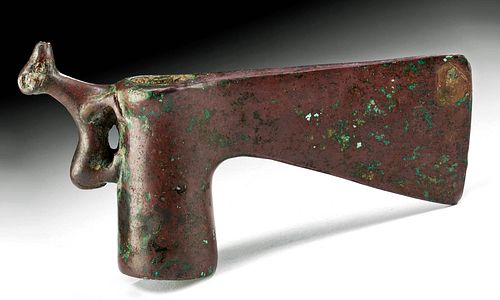Mesopotamian Copper Socketed Axe Head w/ Ram
Lot 59
About Seller
Artemis Gallery
686 S Taylor Ave, Ste 106
Louisville, CO 80027
United States
Selling antiquities, ancient and ethnographic art online since 1993, Artemis Gallery specializes in Classical Antiquities (Egyptian, Greek, Roman, Near Eastern), Asian, Pre-Columbian, African / Tribal / Oceanographic art. Our extensive inventory includes pottery, stone, metal, wood, glass and textil...Read more
Categories
Estimate:
$1,800 - $2,500
Absentee vs Live bid
Two ways to bid:
- Leave a max absentee bid and the platform will bid on your behalf up to your maximum bid during the live auction.
- Bid live during the auction and your bids will be submitted real-time to the auctioneer.
Bid Increments
| Price | Bid Increment |
|---|---|
| $0 | $25 |
| $300 | $50 |
| $1,000 | $100 |
| $2,000 | $250 |
| $5,000 | $500 |
| $10,000 | $1,000 |
| $20,000 | $2,500 |
| $50,000 | $5,000 |
| $100,000 | $10,000 |
| $200,000 | $20,000 |
About Auction
By Artemis Gallery
Oct 8, 2020
Set Reminder
2020-10-08 10:00:00
2020-10-08 10:00:00
America/New_York
Bidsquare
Bidsquare : Exceptional Antiquities, Asian, Ethnographic
https://www.bidsquare.com/auctions/artemis-gallery/exceptional-antiquities-asian-ethnographic-5796
Museum-worthy examples of Egyptian, Greek, Roman, Etruscan, Near Eastern, Far East / Asian, Pre-Columbian, African / Tribal,Oceanic, Native American, Spanish Colonial, Russian, Fossils, Ancient Jewelry, Fine Art, so much more! Artemis Gallery info@artemisgallery.com
Museum-worthy examples of Egyptian, Greek, Roman, Etruscan, Near Eastern, Far East / Asian, Pre-Columbian, African / Tribal,Oceanic, Native American, Spanish Colonial, Russian, Fossils, Ancient Jewelry, Fine Art, so much more! Artemis Gallery info@artemisgallery.com
- Lot Description
Ancient Near East, Mesopotamia, Early Bronze Age, ca. 2500 to 2000 BCE. A stunning axe head forged from copper that has developed incredibly lustrous patina in russet and green hues across its surfaces. The axe head presents with a vertically-oriented trapezoidal blade emanating from the front of a cylindrical socketing shaft with a slightly flared base and a thickened top periphery that aided in reinforcing the tool through countless strikes. Behind the narrow shaft is the effigy of a ram lying recumbent upon all four legs with its body slightly raised and its alert head bearing an incised mouth as well as a grand pair of spiraling horns. Axe heads like this example were perhaps used in ceremonial contexts rather than on the battlefield. Rams in Mesopotamian artistry typically represented fertility and virility; however, they also bore connotations pertaining to Inanna, the goddess of love and vegetation. Size: 5.875" L x 1.25" W x 3.125" H (14.9 cm x 3.2 cm x 7.9 cm)
Cf. The Metropolitan Museum of Art, accession number 57.13.5; also Petrie, W.M. Flinders. "Tools and Weapons." Hazell, Watson and Viney, LD., London, 1917, 1:4, O. Socketted Axe; Pointed, Long and Tubular Sockets; Oriental, fig. 131.
Provenance: ex-estate of Eldert Bontekoe, Pegasi Numismatics, Ann Arbor, Michigan, USA, acquired before 2000
All items legal to buy/sell under U.S. Statute covering cultural patrimony Code 2600, CHAPTER 14, and are guaranteed to be as described or your money back.
A Certificate of Authenticity will accompany all winning bids.
We ship worldwide and handle all shipping in-house for your convenience.
#158935Small nick to one side of blade near edge, with nicks and light pitting to blade faces, socketing shaft, and ram, softening to some finer ram details, and light encrustations within socketing shaft, otherwise intact and excellent. Lustrous patina, fantastic colors, and smooth textures across all surfaces.Condition
- Shipping Info
-
All shipping is handled in-house for your convenience. Your invoice from Artemis Gallery will include shipping calculation instructions. If in doubt, please inquire BEFORE bidding for estimated shipping costs for individual items.
-
- Buyer's Premium



 EUR
EUR CAD
CAD AUD
AUD GBP
GBP MXN
MXN HKD
HKD CNY
CNY MYR
MYR SEK
SEK SGD
SGD CHF
CHF THB
THB

















